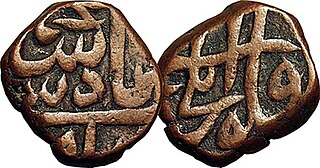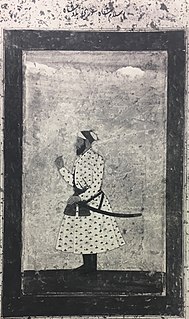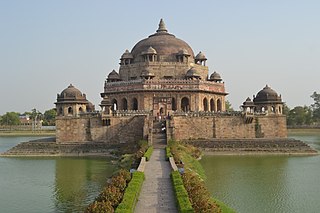 W
WThe Sur Empire was established by an Afghan dynasty which ruled a large territory in the northern part of the Indian subcontinent for nearly 16 years, between 1540 and 1556, with Sasaram, in modern-day Bihar, serving as its capital.
 W
WA Dam was a small Indian copper coin. The coin was first introduced by Sher Shah Suri during his rule of India between 1540 and 1545, along with Mohur, the gold coin and Rupiya the silver coin. Later on, the Mughal Emperors standardised the coin along with other silver (Rupiya) and gold (Mohur) coins in order to consolidate the monetary system across India. A rupee was divided into 40 dams.
 W
WDam was a small coin, either silver, gold or copper first minted during between c. 1098 - 1126 CE., replacing old Licchavi coinage.
 W
WThe Grand Trunk Road formerly known as Uttarapath, Sarak-e-Azam, Badshahi Sarak, Sarak-e-Sher Shah is one of Asia's oldest and longest major roads. For at least 2,500 years, it has linked Central Asia to the Indian subcontinent. It runs roughly, 3,710 km (2,305 mi) from Teknaf, Bangladesh west to Kabul, Afghanistan, passing through Chittagong and Dhaka in Bangladesh, Kolkata, Allahabad (Prayagraj), Delhi, and Amritsar in India, and Lahore, Rawalpindi, and Peshawar in Pakistan.
 W
WHemu was a Hindu king who previously served as a general and Chief Minister of Adil Shah Suri of the Suri dynasty during a period in Indian history when the Mughals and Afghans were vying for power across North India. He fought Afghan rebels across North India from the Punjab to Bengal and the Mughal forces of Humayun and Akbar in Agra and Delhi, winning 22 battles for Adil Shah.
 W
WIsa Khan Niazi was a Pashtun noble in the courts of Sher Shah Suri and his son Islam Shah Suri, of the Sur dynasty, who fought the Mughal Empire.
 W
WIslam Shah Suri was the second ruler of the Suri dynasty which ruled the part of India in the mid-16th century. His original name was Jalal Khan and he was the second son of Sher Shah Suri.
 W
WA mohur is a gold coin that was formerly minted by several governments, including British India and some of the princely states which existed alongside it, the Mughal Empire, Kingdom of Nepal, and Afghanistan. It was usually equivalent in value to fifteen silver rupees. It was last minted in British India in 1918, but some princely states continued to issue the coins until their accession to India after 1947. Similar coins were also issued by the British authorities in denominations of 2⁄3 mohur, 1⁄3 mohur and the double mohur, and some of the princely states issued half-mohur coins.
 W
WMuhammad Adil Shah was the fourth ruler of the Sur dynasty, a late medieval Afghan dynasty of northern India.
 W
WRohtas Fort is a 16th-century fortress located near the city of Jehlum in the Pakistani province of Punjab.The fortress was built during the reign of Sher Shah Suri. The fort was also designed to suppress the local Gakhar tribes of then Potohar region.
 W
WThe Rohtasgarh or Rohtas Fort is located in the Son River valley, in the small town of Rohtas in Bihar, India.it is symbol of kushwaha/kushwanshi dynasty.
 W
WSher Shah Suri, born Farīd Khān, was the founder of the Suri Empire in India, with its capital in Sasaram in modern-day Bihar. He introduced the currency of rupee. An ethnic Afghan, Sher Shah took control of the Mughal Empire in 1538. After his accidental death in 1545, his son Islam Shah became his successor. He first served as a private before rising to become a commander in the Mughal army under Babur and then the governor of Bihar. In 1537, when Babur's son Humayun was elsewhere on an expedition, Sher Shah overran the state of Bengal and established the Suri dynasty. A brilliant strategist, Sher Shah proved himself as a gifted administrator as well as a capable general. His reorganization of the empire laid the foundations for the later Mughal emperors, notably Akbar, son of Humayun.
 W
WThe tomb of Sher Shah Suri is in the Sasaram town of Bihar state, India. The tomb was built in memory of Emperor Sher Shah Suri, a Pathan from Bihar who defeated the Mughal Empire and founded the Suri Empire in northern India. He died in an accidental gunpowder explosion in the fort of Kalinjar on 10th day of Rabi' al-awwal, A.H. 952 or 13 May 1545 AD.
 W
WSher Shah Suri Mosque, also known as Shershahi Mosque, is an example of the Afghan style of architecture. Sher Shah Suri built this mosque in 1540–1545 to commemorate his reign. It is sited in the south-west corner of Purab Darwaza near Dhawalpura.
 W
WSikandar Shah Suri was the sixth ruler of Sur dynasty, a late medieval Pashtun dynasty of northern India. He became the sultan of Delhi after overthrowing Ibrahim Shah Suri.
 W
WAdil Shah Suri was the seventh and final ruler of the Sur dynasty. He was the brother of Sikandar Shah Suri, who ruled over a region east of Delhi after Sikandar Shah Suri was defeated by Humayun in 1555. He and Sikandar Shah Suri were contenders for the Delhi throne against the Mughal emperor Akbar the Great.